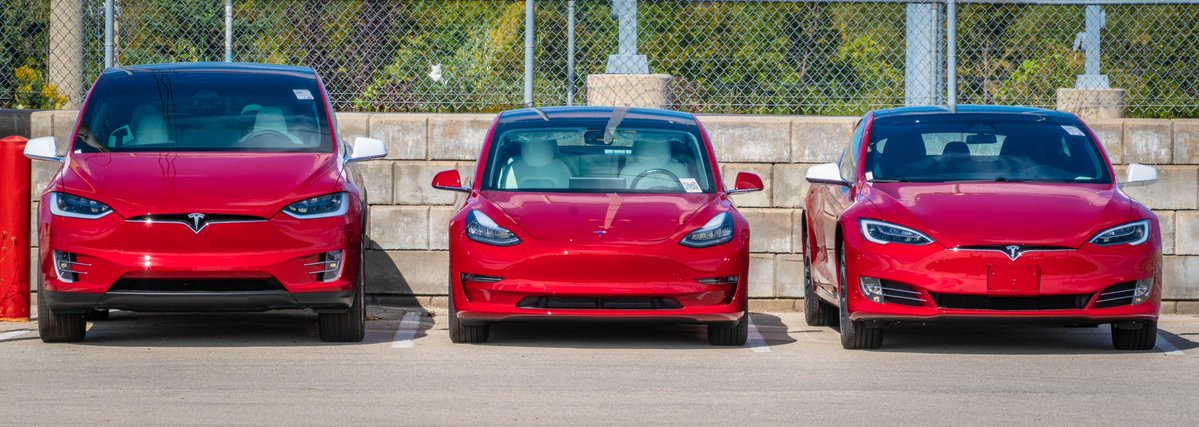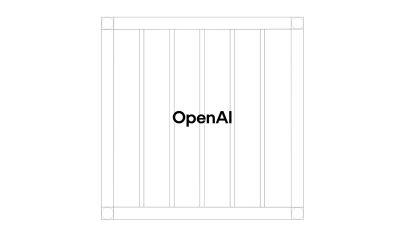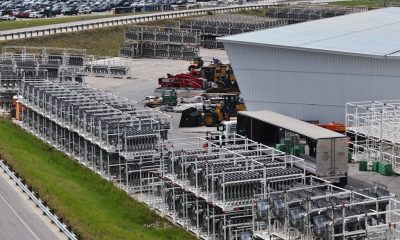

News
Tesla’s 75 kWh battery pack removal opens doors to ‘Track Mode’ for Model S & X
In a recent update on Twitter, Elon Musk announced that Tesla would be discontinuing the 75 kWh variants of the Model S and Model X. Starting this coming Monday, Tesla’s two flagship vehicles would only be offered at 100 kWh and 100 kWh Performance versions, widening the price gap between the cars and the company’s newest offering — the Model 3.
In a way, retiring the 75D line seems to be the right decision for Tesla. After all, the Model S 75D, which is priced at $76,000 before options, pretty much overlaps with the price of a fully-loaded Model 3 Performance. That said, this change also results in the base price of the Model S and Model X increasing significantly. The Model S 100D — the vehicle’s base version starting Monday — would start at $94,000, while the Model X 100D would start at $97,000, far higher than the Model X 75D’s starting price of $82,000.
Starting on Monday, Tesla will no longer be taking orders for the 75 kWh version of the Model S & X. If you’d like that version, please order by Sunday night at https://t.co/46TXqRJ3C1
— Elon Musk (@elonmusk) January 9, 2019
Apart from widening the gap between the more affordable Model 3 and the flagship Model S and X, though, the retirement of the 75 kWh battery pack also opens the doors to a very likely battery upgrade for the full-size sedan and SUV. The Model S and X, after all, are still equipped with 18650 cells, which are smaller and a bit older than the 2170 cells being used on the Model 3. These cells are also imported from Panasonic’s facilities in Japan, instead of being produced in Gigafactory 1.
By retiring the 75 kWh battery pack, Tesla would give itself an opportunity to roll out the newer cells to its flagship vehicles. The 2170 cells, for one, would probably even allow the Performance-branded Model S and X to handle extended track driving. Part of the reason behind the current generation Model S and X’s inability to be competitive on the track, after all, is their batteries, which have a tendency to overheat after a few laps around a closed circuit. This particular issue has been largely addressed by Tesla with the Model 3 and its 2170 cells, as evidenced by the vehicle’s dedicated Track Mode setting.
A Track Mode feature for the Performance Model S and X would make the vehicles even more fearsome than they already are. Even with their general inability to be driven on a racecourse, the Model S and Model X have nonetheless developed a reputation as monsters in straight-line races over the years. Equipped with a battery that has the same tech as the Model 3 — from its 2170 cells to its clever cooling systems — the Model S and X would be downright frightening.

Apart from opening the doors to Track Mode, an update to 2170 cells would likely result in more range for the Model S and Model X as well. This is something that Tesla could definitely use as a selling point for its flagship vehicles, considering that the competition, including the Porsche Taycan and the Jaguar I-PACE, are still pretty much competing against the bar set by vehicles that were created during the 18650 cell era. One can only speculate how much range a Long Range version of the Model S would have if it were equipped with 2170 cells. Perhaps even a 400-mile range? Such a scenario is plausible.
Hidden within this new update from Elon Musk, though, is something that bodes well for the company’s upcoming vehicle — the Model Y. Seeing as Tesla retired the Model X 75D, the company’s only SUV in its lineup now starts at $97,000. That’s very expensive, and this price notably reduces the size of the vehicle’s potential consumer base in an incredibly popular segment. By adopting this strategy at this point, Tesla appears to be hinting at the release of another, more affordable SUV that can compete more aggressively than the entry-level Model X. This vehicle, of course, would be the Model Y.
The Model Y has been in the rumor mill for some time now. In recent months, though, Elon Musk has provided a number of updates on the vehicle. During the company’s third-quarter earnings call, for one, Musk mentioned that he had already approved the construction of the Model Y’s alpha prototype. Musk has also joked that the upcoming SUV would be unveiled this 2018, perhaps sometime in the first half of the year.
News
These Tesla, X, and xAI engineers were just poached by OpenAI
The news is the latest in an ongoing feud between Elon Musk and the Sam Altman-run firm OpenAI.

OpenAI, the xAI competitor for which Elon Musk previously served as a boardmember and helped to co-found, has reportedly poached high-level engineers from Tesla, along with others from xAI, X, and still others.
On Tuesday, Wired reported that OpenAI hired four high-level engineers from Tesla, xAI, and X, as seen in an internal Slack message sent by co-founder Greg Brockman. The engineers include Tesla Vice President of Software Engineering David Lau, X and xAI’s head of infrastructure engineering Uday Ruddarraju, and fellow xAI infrastructure engineer Mike Dalton. The hiring spree also included Angela Fan, an AI researcher from Meta.
“We’re excited to welcome these new members to our scaling team,” said Hannah Wong, an OpenAI spokesperson. “Our approach is to continue building and bringing together world-class infrastructure, research, and product teams to accelerate our mission and deliver the benefits of AI to hundreds of millions of people.”
Lau has been in his position as Tesla’s VP of Software Engineering since 2017, after previously working for the company’s firmware, platforms, and system integration divisions.
“It has become incredibly clear to me that accelerating progress towards safe, well-aligned artificial general intelligence is the most rewarding mission I could imagine for the next chapter of my career,” Lau said in a statement to Wired.
🚨Optimistic projections point to xAI possibly attaining profitability by 2027, according to Bloomberg's sources.
If accurate, this would be quite a feat for xAI. OpenAI, its biggest rival, is still looking at 2029 as the year it could become cash flow positive.💰 https://t.co/pE5Z9daez8
— TESLARATI (@Teslarati) June 18, 2025
READ MORE ON OPENAI: Elon Musk’s OpenAI lawsuit clears hurdle as trial looms
At xAI, Ruddarraju and Dalton both played a large role in developing the Colossus supercomputer, which is comprised of over 200,000 GPUs. One of the major ongoing projects at OpenAI is the company’s Stargate program,
“Infrastructure is where research meets reality, and OpenAI has already demonstrated this successfully,” Ruddarraju told Wired in another statement. “Stargate, in particular, is an infrastructure moonshot that perfectly matches the ambitious, systems-level challenges I love taking on.”
Elon Musk is currently in the process of suing OpenAI for shifting toward a for-profit model, as well as for accepting an investment of billions of dollars from Microsoft. OpenAI retaliated with a counterlawsuit, in which it alleges that Musk is interfering with the company’s business and engaging in unfair competition practices.
Elon Musk confirms Grok 4 launch on July 9 with livestream event
News
SpaceX share sale expected to back $400 billion valuation
The new SpaceX valuation would represent yet another record-high as far as privately-held companies in the U.S. go.

A new report this week suggests that Elon Musk-led rocket company SpaceX is considering an insider share sale that would value the company at $400 billion.
SpaceX is set to launch a primary fundraising round and sell a small number of new shares to investors, according to the report from Bloomberg, which cited people familiar with the matter who asked to remain anonymous due to the information not yet being public. Additionally, the company would sell shares from employees and early investors in a follow-up round, while the primary round would determine the price for the secondary round.
The valuation would represent the largest in history from a privately-owned company in the U.S., surpassing SpaceX’s previous record of $350 billion after a share buyback in December. Rivaling company valuations include ByteDance, the parent company of TikTok, as well as OpenAI.
Bloomberg went on to say that a SpaceX representative didn’t respond to a request for comment at the time of publishing. The publication also notes that the details of such a deal could still change, especially depending on interest from the insider sellers and share buyers.
Axiom’s Ax-4 astronauts arriving to the ISS! https://t.co/WQtTODaYfj
— TESLARATI (@Teslarati) June 26, 2025
READ MORE ON SPACEX: SpaceX to decommission Dragon spacecraft in response to Pres. Trump war of words with Elon Musk
SpaceX’s valuation comes from a few different key factors, especially including the continued expansion of the company’s Starlink satellite internet company. According to the report, Starlink accounts for over half of the company’s yearly revenue. Meanwhile, the company produced its 10 millionth Starlink kit last month.
The company also continues to develop its Starship reusable rocket program, despite the company experiencing an explosion of the rocket on the test stand in Texas last month.
The company has also launched payloads for a number of companies and government contracts. In recent weeks, SpaceX launched Axiom’s Ax-4 mission, sending four astronauts to the International Space Station (ISS) for a 14-day stay to work on around 60 scientific experiments. The mission was launched using the SpaceX Falcon 9 rocket and a new Crew Dragon capsule, while the research is expected to span a range of fields including biology, material and physical sciences, and demonstrations of specialized technology.
News
Tesla Giga Texas continues to pile up with Cybercab castings
Tesla sure is gathering a lot of Cybercab components around the Giga Texas complex.

Tesla may be extremely tight-lipped about the new affordable models that it was expected to start producing in the first half of the year, but the company sure is gathering a lot of Cybercab castings around the Giga Texas complex. This is, at least, as per recent images taken of the facility.
Cybercab castings galore
As per longtime drone operator Joe Tegtmeyer, who has been chronicling the developments around the Giga Texas complex for several years now, the electric vehicle maker seems to be gathering hundreds of Cybercab castings around the factory.
Based on observations from industry watchers, the drone operator appears to have captured images of about 180 front and 180 rear Cybercab castings in his recent photos.
Considering the number of castings that were spotted around Giga Texas, it would appear that Tesla may indeed be preparing for the vehicle’s start of trial production sometime later this year. Interestingly enough, large numbers of Cybercab castings have been spotted around the Giga Texas complex in the past few months.
Cybercab production
The Cybercab is expected to be Tesla’s first vehicle that will adopt the company’s “unboxed” process. As per Tesla’s previous update letters, volume production of the Cybercab should start in 2026. So far, prototypes of the Cybercab have been spotted testing around Giga Texas, and expectations are high that the vehicle’s initial trial production should start this year.
With the start of Tesla’s dedicated Robotaxi service around Austin, it might only be a matter of time before the Cybercab starts being tested on public roads as well. When this happens, it would be very difficult to deny the fact that Tesla really does have a safe, working autonomous driving system, and it has the perfect vehicle for it, too.
-

 Elon Musk1 week ago
Elon Musk1 week agoTesla investors will be shocked by Jim Cramer’s latest assessment
-

 News2 weeks ago
News2 weeks agoTesla Robotaxi’s biggest challenge seems to be this one thing
-

 Elon Musk1 day ago
Elon Musk1 day agoElon Musk confirms Grok 4 launch on July 9 with livestream event
-

 News2 weeks ago
News2 weeks agoWatch the first true Tesla Robotaxi intervention by safety monitor
-

 News5 days ago
News5 days agoTesla Model 3 ranks as the safest new car in Europe for 2025, per Euro NCAP tests
-

 Elon Musk2 weeks ago
Elon Musk2 weeks agoA Tesla just delivered itself to a customer autonomously, Elon Musk confirms
-

 Elon Musk2 weeks ago
Elon Musk2 weeks agoElon Musk confirms Tesla Optimus V3 already uses Grok voice AI
-

 Elon Musk2 weeks ago
Elon Musk2 weeks agoxAI welcomes Memphis pollution results, environmental groups push back


















